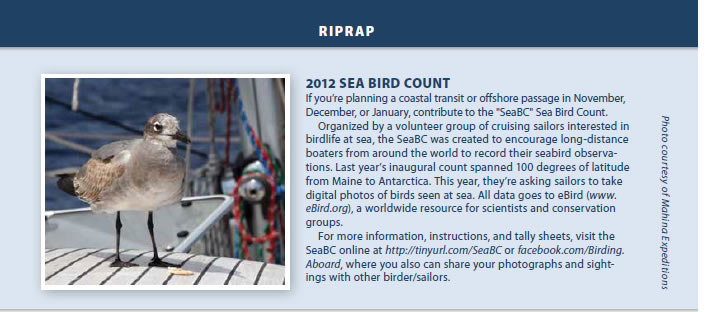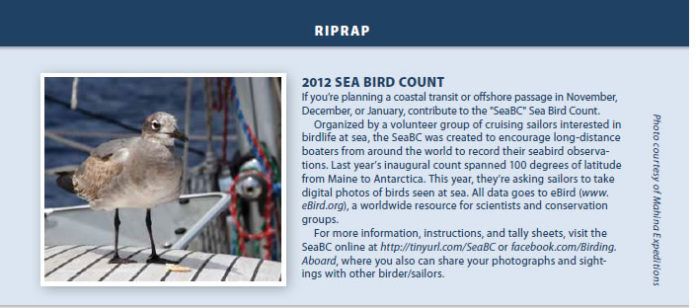I used to have a Uniden UM525 VHF radio with two wireless WHAMx4 mics aboard: one at the helm (with separate charging station inside for security) and one in the main berth. This was excellent as it enabled the on-watch crew to call up off-watch crew in an emergency (using the intercom feature)—or more often, the off-watch crew could ask “what was that noise?” without having to get out of bed.
As a husband-and-wife sailing team, we found this feature fantastic on long passages. We now have a new boat that came with a Standard Horizon GX2100 VHF radio installed. We did not find a wireless remote mic available for it in our search (too bad your September 2012 review of remote mics didn’t arrive a couple of months earlier!), and we purchased the recommended wired mic. However, we were really unhappy to find we could only have one remote mic for the radio.
Maryanne & Kyle Webb
Begonia, Fountaine Pajot Athena 38
Portland, Ore.
The only wireless remote mic in the September test was the PS Recommended Garmin GHS-20, which allows connecting up to three mics, and it has the intercom function. If you’re up for wiring multiple mics, several makers offer products that will allow mic-to-mic communication. Standard Horizon’s GX5500S (PS Best Choice, October 2009) supports multiple wired remote mics and has the mic-to-mic and mic-to-base intercom function.
Another option for wireless berth-to-cockpit communication is the Family Radio Service (FRS), or what’s more widely referred to as two-way walkie-talkies. You can find a decent, waterproof set for $50-$75 online.
As a retiree who worked in the paint business on three continents for most of my life, my sympathies go out to Jack Valdouw for his “Bottom Paint Woes” (Mailport, September 2012). Valdouw’s problems are a perfect example of how insane government regulations have pushed marine paint makers to an impossible technical position in coating formulations. (I should state that I have never worked for West Marine or its supplier.)
Attacks on antifouling ingredients within the U.S. Environmental Protection Agency have pushed most commercial ocean-going dry-docking to China and the Far East, where no such bans exist, and the planet remains no less polluted. One “bright” non-sailing California environmentalist, recently suggested that yacht owners dry-dock every six weeks for high-pressure water washing and vacuum up any contaminated slime.
What part of “antifouling” do they not understand? Following the law of unintended consequences, our government regulations of reduced or no copper, no biocides, and even no zinc compounds will eventually slow the U.S. recreational yachting community to drifting at 2 knots in a 15-knot wind because of barnacles and fouling, unless someone stops the madness of this well-meaning but ignorant bureaucratic nonsense.
Michael R. Bingham.
Houston, Texas.
The Canadian builder, now apparently defunct, of two wooden masts for my Benford 34 junk-rigged schooner inexplicably ignored the plan for the foremast I sent him, and he did not provide a way to pull a lightning conductor through it.
Drilling 10 inches into the center of the masthead suggests no cavity. In your judgment, is there a reasonable way to run an AWG 4 cable outside the mast to a suitable submerged copper sheet—as I will for the mainmast, which if the 45-degree rule is correct, will not protect the head of the foremast? I’m asking you because I sense you and your associates like compound, probalistic, and ambiguous problems of this sort!
Stephen Sittler
Benford 34
An outside-the-spar run of 4-gauge wire, though not elegant, will work on a wooden spar, as long as hoops are not the chosen mode of sail attachment. Be sure to avoid potential chafe points, and add chafe protection if needed; also, we recommend using plastic straps rather that stainless straps to hold the wire run in place.
If possible, the wire should not be cut, and avoid a terminal connection where the wire penetrates the deck. Perhaps it can be led through the partners directly to the bilge, where an unbroken connection is made to the external underwater conductor.
In March 2010, you reviewed inverters and chargers and gave the Xantrex Prosine 2.0 outstanding marks, which made me happy because I had one. What you could not have tested, perhaps, is the fact that the remote panel that enables all the functions is a lemon. I have had to replace mine twice within a year. Surfing the Internet for solutions revealed that the problem is epidemic. Perhaps an update on your review would be timely.
Incidentally, the remote panel can be used to configure the system to work without a remote panel; however, one needs a working remote panel to do that.
Victor Villagra
Via email
Xantrex reported receiving a “few service calls” about the remote panel, and “on a rare occasion,” the panels were deemed defective. The company attributed the panel failures to external factors like stress from electromagnetic fields and surges on the AC/DC side, which can reduce the panel’s life expectancy.
Xantrex recommends that anyone with an ailing Prosine 2.0 remote panel first try disconnecting the cable port on the panel back and let it sit for 5 minutes to reset, then plug it back in. If that doesn’t fix the problem, check the phone cable and connectors at both ends, and replace any that show signs of corrosion or dirt on the contacts. If all else fails, contact Xantrex customer service via email at [email protected].
I was searching the Internet for sea voyages and solo navigators, and came across Matt Rutherford’s journey (PS, July 2012). This story is amazing, and so was his accomplishment. What got me so excited was that it is 2012, and yet, there was still an adventure to be had and a record to be broken.
In a time when we can travel in space and cross worlds in the blink of an eye, here is this amazing person who spent over 300 days on a 27-foot boat to do something no one had ever done before. He didn’t have mechanics or mathematicians calculating angles and risks; he had only the hopes the sun would smile upon his face, the wind would always be at his back, and the sea would be his friend.
By all rights, Matt Rutherford has earned his place in history and shares his great feat with the likes of Columbus, Magellan, and of course, Saint Brendan, the navigator. Thank you, Matt, for giving me, and all of us who were with you throughout your journey, the adventure, the thrill, and the realization that there are still records to be broken, adventures to be had, and discoveries to be made. May this always keep you smiling: You did real good.
Don Kimball
Alberg 30
Connecticut
Regarding your advice on chemical strippers for varnish (PS Advisor, August, 2012): I have had very good results using Sunnyside Corp.’s Back to Nature Ready-Strip. It contains no methylene chloride, is safe on fiberglass, cleans up with water, and is much less expensive than Franmar’s Soy Strip. It claims to be environmentally safe as well.
David McMillin
Endless Summer, Ranger 33
Houston, Texas
Thanks for the feedback. Practical Sailor tested Ready-Strip against Soy Strip and other chemical marine strippers in the November 2006 issue. While Soy Strip got the Best Choice pick, the significantly less expensive Ready-Strip was the Budget Buy.
I have a suggestion, with a few caveats, for a sailing short that I’ve worn for decades: Stand-Up shorts made by Patagonia (www.patagonia.com). Made of heavy-duty cotton canvas, with two large rear pockets (forming a double layer seat), and wide leg openings, they wear well, are very comfortable, and cool—plus the leg design and standard inseam won’t pull the hairs on top of your legs when you squat down or climb onto something. The front pockets are wide and deep. I regularly stuff the two large rear pockets with tools when working on something, which is very handy, but you could easily cut closed-cell foam to fit in them for rail-riding wear.
The caveats: They don’t dry as fast as your test subjects, and they’ll stink if they are soaked in saltwater, then stored in a black trash bag for 72 hours, but anything cotton would.
They make a great general-purpose short that’ll go the distance and are priced around $50.
Mark Florian
Austin, Texas
In regards to your article on chafe gear in the July 2011 issue: I really like the idea of fashioning leather chafe guards, and I will make some when I am settled into an anchorage. In the meantime, I have installed a product called Trach Mate Spiroll onto my lines. It is easy to install as it comes in the form of a rolled length of material that wraps around the line. So far, it hasn’t shown any signs of wear nor slid along the line from where I put it. I would love to hear from anyone who has used this product for a longish period of time as to how it has held up.
Frances Stateler
San Francisco, Calif.
We’ll add Spiroll to our test roster, but be sure to check out page 16 for the results of Round 2 of our chafe gear tests.



































